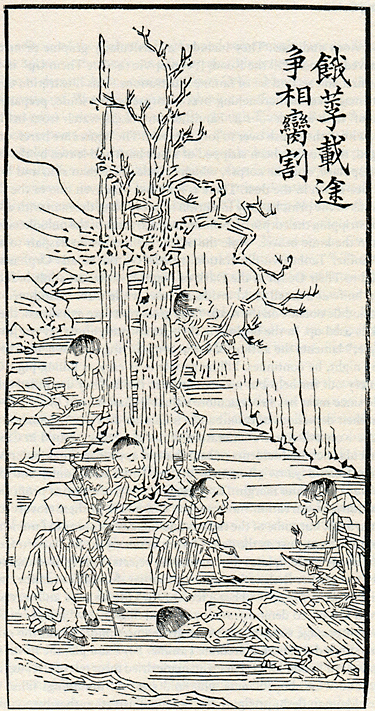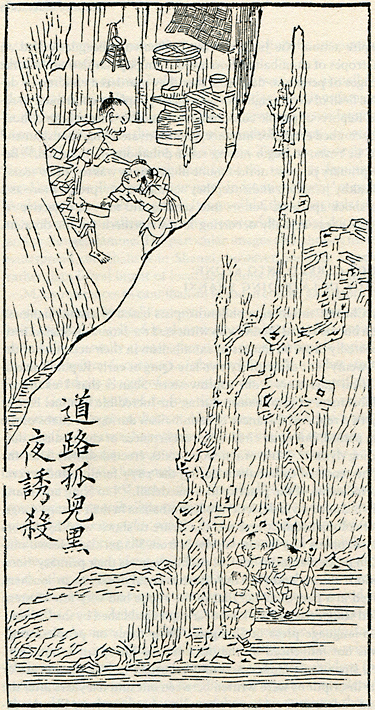| |
FAMINE & PHILANTHROPY
The leading Chinese-language newspaper in late nineteenth-century China, the Shanghai-based Shenbao, began in 1877 and 1878 to cover on an almost daily basis the famine engulfing North China. The news that millions of people were starving to death in the drought-stricken northern provinces shocked Chinese reformers and gentry philanthropists living in Shanghai and other parts of the Jiangnan region into action. [11] The extra-governmental famine relief effort that resulted was unprecedented in scope and style. By the summer of 1878, gentry and merchant relief organizers had established special relief offices in Shanghai, Suzhou, Hangzhou, and Yangzhou. Over the next three years these centers cooperated to raise over a million taels (about $1,300,000 in 1878) for famine relief. Such elite-run relief efforts cooperated with, but remained separate from, the official relief-coordinating bureau in Tianjin, which was established early in 1878, and which also targeted Shanghai as a center of official fund-raising. [12]
In their concerted effort to limit the pernicious effects of the famine, influential members of the Jiangnan elite drew ideas from Chinese texts and philanthropic traditions. The poetic laments accompanying each of the Taohuawu public hall’s famine illustrations, for instance, use descriptive phrases strikingly similar to those found in the Qingshiduo, an anthology of poems from the Qing period that was compiled by a Zhejiangese scholar just a decade before the famine. [13]
The decision to depict the suffering of disaster victims visually as well as in writing stemmed from Jiangnan’s regional philanthropic tradition. A few decades before the Incredible Famine, a leading Jiangnan philanthropist named Yu Zhi designed two volumes of “pictures to draw tears from iron” in order to raise relief funds for victims of the Jiangnan flood disaster of 1850 and the Taiping wars of the 1850s and early 1860s. The immistakeable similarities between the style and content of the illustrations in Xie Jiafu’s Henan qihuang tieleitu and those in Yu Zhi’s Jiangnan tieleitu show that Xie was deeply influenced by the earlier work. [14]
The subject matter of the Taohuawu public hall’s “pictures to draw
tears from iron” also drew heavily on China’s long tradition of
describing disasters. A particularly shocking image that appears in
gazetteer essays, Shenbao articles, and the illustrated pamphlets is
that of famine-related cannibalism. Xie Jiafu and his Taohuawu
colleagues appear to have employed images of cannibalism as part of
their effort to draw both tears and donations from even the most
impervious audience.
|
|
| |
 They included a particularly graphic print titled “Starved Corpses Fill the Road; [People] Vie to Slice Them Up,” in both their first and second set of famine illustrations. This picture depicts two emaciated men crouching over a corpse with a knife, preparing to slice off flesh and devour it. Famished onlookers watch from behind a tree, and others rush over to join the feast. The figures are barefoot and ragged, the tree has been stripped of all its bark and leaves by the starving populace, and the corpse, which is little more than skin and bones, lies face down in the dust. [15] They included a particularly graphic print titled “Starved Corpses Fill the Road; [People] Vie to Slice Them Up,” in both their first and second set of famine illustrations. This picture depicts two emaciated men crouching over a corpse with a knife, preparing to slice off flesh and devour it. Famished onlookers watch from behind a tree, and others rush over to join the feast. The figures are barefoot and ragged, the tree has been stripped of all its bark and leaves by the starving populace, and the corpse, which is little more than skin and bones, lies face down in the dust. [15]
|
 |
 People Eating People— People Eating People—
“Starved corpses fill the road; people vie to slice them up.”
“Si sheng gao zai tu qi,” 13a
[t012]
see also Legge plate VI. |
 |

Another Taohuawu illustration, this one titled “On the Roads Orphans are Lured to Their Death in the Dark of Night,” shows an adult brandishing a knife at a small child, while three abandoned children huddle outside on the road. “The grass roots are exhausted, the tree bark is used up. In the beginning they ate corpses; now they eat [living] people,” laments the author of the accompanying text. Whether by day or by night, he continues, killing people is as easy as killing pigs. Children cry out for help but no one answers them. They are killed with a knife since meat has become more valuable than human life. [16]
|
 Famine Orphans Lured Famine Orphans Lured
to Their Deaths—
“On the roads orphans are lured to their death in the dark of night.”
“Si sheng gao zai tu qi,” 24a
[t013]
| |
| |
The decision to employ powerful tropes of cannibalism, possibly borrowed from the distinctive “literature of the grotesque” found in popular works such as Romance of the Three Kingdoms and Water Margins, sometimes succeeded in convincing people to become involved in relief work. The Zhejiangese merchant-philanthropist Jing Yuanshan, for instance, wrote that it was rumors of people consuming one another across a thousand li of scorched earth that first motivated Jing and his friend Li Yushu to begin raising relief donations in Shanghai. [17]
In their effort to motivate people to donate to relief efforts, Xie Jiafu and his Taohuawu colleagues also called on belief systems and fund-raising methods that had deep roots in late-imperial Chinese society. China’s tradition of famine relief appropriated diverse strands of thought, ranging from the basic Confucian ideal of humaneness and the concern for the well-being of the common people, to Legalist strands which emphasized the manipulation of rewards and punishments, to popular Buddhist teachings about the oneness of all creatures. [18]
|
|
| |

|
|
|





